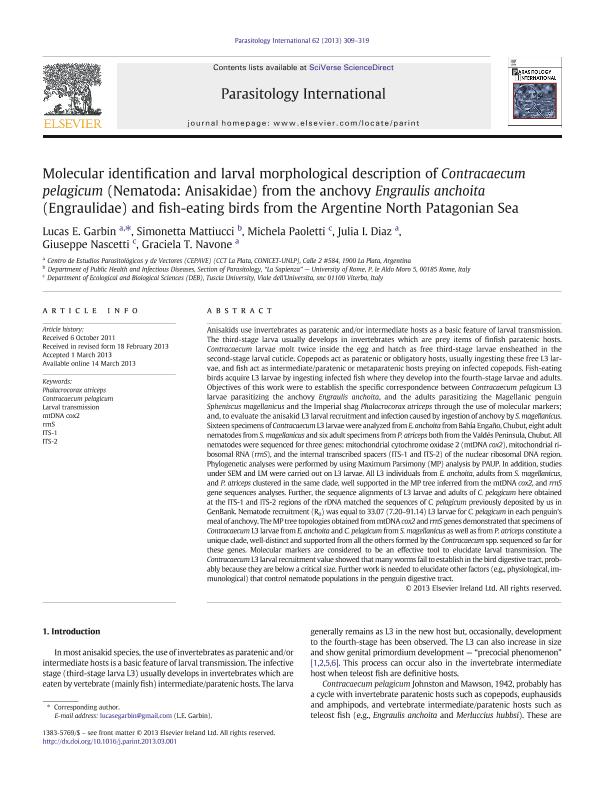Artículo
Molecular identification and larval morphological description of Contracaecum pelagicum (Nematoda: Anisakidae) from the anchovy Engraulis anchoita (Engraulidae) and fish-eating birds from the Argentine North Patagonian Sea
Garbin, Lucas ; Matiucci, Simonetta; Paoletti, Michela; Diaz, Julia Inés
; Matiucci, Simonetta; Paoletti, Michela; Diaz, Julia Inés ; Nascetti, Giuseppe; Navone, Graciela Teresa
; Nascetti, Giuseppe; Navone, Graciela Teresa
 ; Matiucci, Simonetta; Paoletti, Michela; Diaz, Julia Inés
; Matiucci, Simonetta; Paoletti, Michela; Diaz, Julia Inés ; Nascetti, Giuseppe; Navone, Graciela Teresa
; Nascetti, Giuseppe; Navone, Graciela Teresa
Fecha de publicación:
03/2013
Editorial:
Elsevier Ireland
Revista:
Parasitology International
ISSN:
1383-5769
Idioma:
Inglés
Tipo de recurso:
Artículo publicado
Clasificación temática:
Resumen
The third-stage larva usually develops in invertebrates which are prey items of finfish paratenic hosts. Contracaecum larvae molt twice inside the egg and hatch as free third-stage larvae ensheathed in the second-stage larval cuticle. Copepods act as paratenic or obligatory hosts, usually ingesting these free L3 larvae, and fish act as intermediate/paratenic or metaparatenic hosts preying on infected copepods. Fish-eating birds acquire L3 larvae by ingesting infected fish where they develop into the fourth-stage larvae and adults. Objectives of this work were to establish the specific correspondence between Contracaecum pelagicum L3 larvae parasitizing the anchovy Engraulis anchoita, and the adults parasitizing the Magellanic penguin Spheniscus magellanicus and the Imperial shag Phalacrocorax atriceps through the use of molecular markers; and, to evaluate the anisakid L3 larval recruitment and infection caused by ingestion of anchovy by S. magellanicus. Sixteen specimens of Contracaecum L3 larvae were analyzed from E. anchoita fromBahía Engaño, Chubut, eight adult nematodes from S.magellanicus and six adult specimens fromP. atriceps both from the Valdés Peninsula, Chubut. All nematodes were sequenced for three genes: mitochondrial cytochrome oxidase 2 (mtDNA cox2), mitochondrial ribosomal RNA (rrnS), and the internal transcribed spacers (ITS-1 and ITS-2) of the nuclear ribosomal DNA region. Phylogenetic analyses were performed by using Maximum Parsimony (MP) analysis by PAUP. In addition, studies under SEM and LM were carried out on L3 larvae. All L3 individuals from E. anchoita, adults from S. magellanicus, and P. atriceps clustered in the same clade, well supported in the MP tree inferred from the mtDNA cox2, and rrnS gene sequences analyses. Further, the sequence alignments of L3 larvae and adults of C. pelagicum here obtained at the ITS-1 and ITS-2 regions of the rDNA matched the sequences of C. pelagicum previously deposited by us in GenBank. Nematode recruitment (Ro) was equal to 33.07 (7.20–91.14) L3 larvae for C. pelagicum in each penguin´s meal of anchovy. TheMP tree topologies obtained frommtDNA cox2 and rrnS genes demonstrated that specimens of Contracaecum L3 larvae fromE. anchoita and C. pelagicum from S. magellanicus as well as from P. atriceps constitute a unique clade,well-distinct and supported from all the others formed by the Contracaecum spp. sequenced so far for these genes. Molecular markers are considered to be an effective tool to elucidate larval transmission. The Contracaecum L3 larval recruitment value showed that many worms fail to establish in the bird digestive tract, probably because they are below a critical size. Further work is needed to elucidate other factors (e.g., physiological, immunological) that control nematode populations in the penguin digestive tract.
Palabras clave:
Paratenic Hosts
,
Contracaecum Pelagicum
,
Larval Transmision
Archivos asociados
Licencia
Identificadores
Colecciones
Articulos(CEPAVE)
Articulos de CENTRO DE EST.PARASITOL.Y DE VECTORES (I)
Articulos de CENTRO DE EST.PARASITOL.Y DE VECTORES (I)
Citación
Garbin, Lucas; Matiucci, Simonetta; Paoletti, Michela; Diaz, Julia Inés; Nascetti, Giuseppe; et al.; Molecular identification and larval morphological description of Contracaecum pelagicum (Nematoda: Anisakidae) from the anchovy Engraulis anchoita (Engraulidae) and fish-eating birds from the Argentine North Patagonian Sea; Elsevier Ireland; Parasitology International; 62; 3; 3-2013; 309-319
Compartir
Altmétricas



